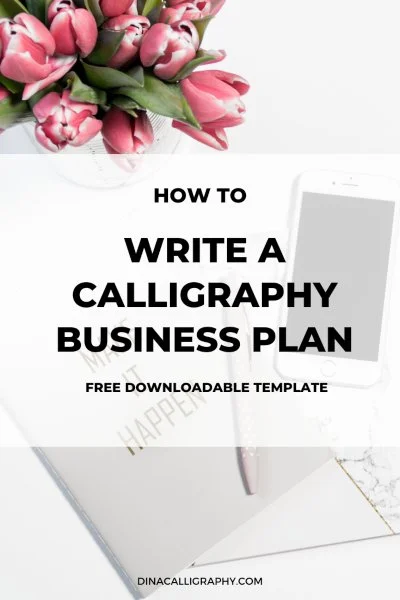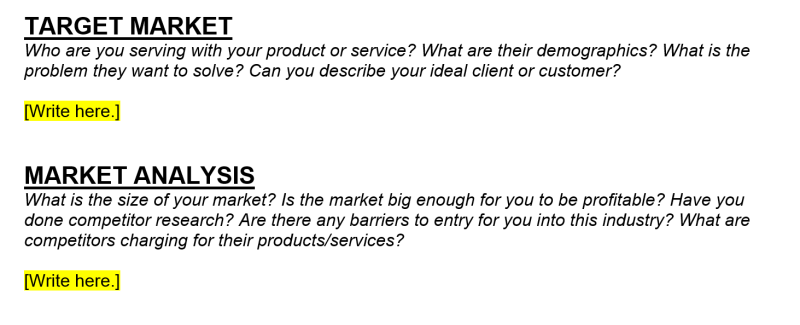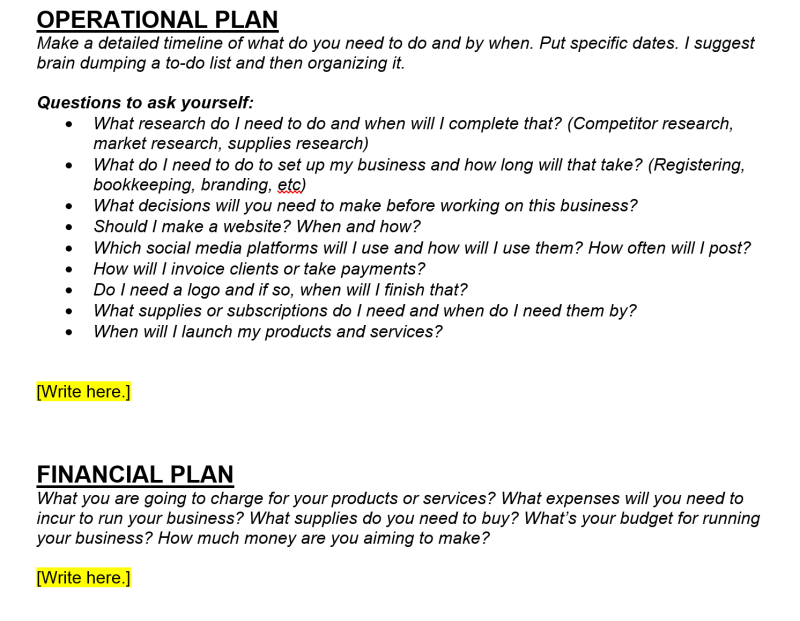How to Write a Calligraphy Business Plan for Calligraphers Starting a New Business
So you want to start a calligraphy business, but you don’t know where to start?
A business plan is a great way to plan out what you envision for your business and specific milestones to meet along the way.
Every business has a business plan, whether it’s a plan in your head or on paper. Sometimes, small businesses, and especially creative businesses, don’t really have a formal plan at the beginning. Often, these small businesses will start off as a side business offering a specific service and then evolve into something bigger.
When I was in business school a few years ago, I learned all about business plans. I’ve created countless plans and reviewed the business plans of companies in several industries.
Before we learn about how to create a business plan, I want to address the question of why it’s so important to make a plan before you start.
“Why should I create a business plan? Do I have to create a business plan?”
A business plan is important when starting a business because it outlines the general vision of the business, the target market of the business’s product or service, and where it eventually wants to go in the future.
I like to compare making a business plan to making a plan for a vacation trip. How long do you spend on planning a vacation trip? I’m guessing weeks, right?! And how specific do you go with your research and logistical planning? Very specific. Of course, there are the vacationers who don’t at all and like to wander around, but the average person will plan to some extent right? You want to make the most out of your time on vacation, so you research all the things you can do, and you drill it down to the most important things.
So that’s what I want you to do with your business.
I created this simple business plan template you can download if you join my free Facebook group Calligraphy Business Bosses. You can download it in the “files” section of the group.
PLAN IT OUT TO AN EXTENT. AT LEAST THE FIRST TIME YOU DO IT.
But, be open to your plan evolving with time. Things will change when you start running your business, so make a plan, but be open minded that it can change. (Because it will!)
In my 1.5 years of running my calligraphy business, I’ve actually made 8 plans—some are revisions. Whenever I felt like I was going off track, I would review my business plan and see how I wanted to revise it.
If you have time and are serious about your business, I’d recommend making a business plan. It doesn’t have to be 100 pages long, but it should be substantial. My own business plans are about 3-5 pages long.
Most importantly, it helps you to break down your business in different parts so you don’t feel overwhelmed. I love planning in my head, but it gets mumble jumbled when there’s too much going on.
“I feel overwhelmed making a business plan—what should I do?”
In the end, I don’t want you to be stuck. If you absolutely cannot bring yourself to make a plan, then don’t. I’d rather have you start on doing SOMETHING in your business than not do anything at all because you’re stuck making a business plan.
Remember: A business plan isn’t a scary document. You don’t need to show it to anyone. You aren’t getting graded on it. You’re not submitting it to any authority like the CRA or the (US version). You don’t even need to follow the guidelines in this blog post.
Make a plan that makes sense for you.
Make a realistic plan that you can follow. Even if it’s 1 or 2 pages long.
If you Google “how to write a business plan”, you’re going to find thousands of blog posts and templates about business plans. That’s because there’s no one way to write a business plan. So then, how should you write it?
This blog post is different from the rest you’ll find on the internet because I’m specifically talking about business plans for calligraphy business—and not just calligraphy business plans, but business plans for the calligrapher who is a solo entrepreneur.
I’m sure 90% of you calligraphers reading this are starting off alone and don’t have plans to hire a team. The business plans you’ll find online are very broad in terms of covering industry.
I’ve adapted this blog post to helping calligraphers wanting to start a calligraphy business by themselves. I’m simplifying a lot in this blog post on business plans because if you don’t have a business background, I don’t want you to feel confused about business jargon!
Part 1: The “why”
VISION AND DREAM
Whenever you start for business plan templates, you’ll find that at the beginning is the big thing that the company wants to do: Call it a vision statement, a mission statement, or just a dream.
Ask yourself: What’s the point of doing all this?
What’s the impact you want this business to make on your own life?
What’s the impact you want this business to make on the world?
For me, the whole point of me running a business is so that I can achieve my lifestyle dream—call it selfish if you will, but this is what rings true to me:
For you, your vision might be that you want some extra income on the side of your full-time job for now, and then decide later if you want to do calligraphy full-time. Your vision or dream doesn’t have to be a LIFE vision. Just what you KNOW you want to do for NOW. For me, I know what my life’s dream is—I’m sure it will change in the future, but this is my life’s dream for NOW.
SMART GOAL THAT’S 1-2 YEARS AWAY
I also like to include a short-term, measurable goal that’s 1-2 years away—ie. Includes a number! It doesn’t have to be monetary like the one I have below: It can be the number of client projects you do, or number of craft markets you sell at, or number of cards you sell on Etsy.
Following SMART goal guidelines (specific, measurable, achievable, realistic, and timely) and you won’t go wrong!
Part 2: The “who”
TARGET MARKET: WHO ARE YOU SERVING?
This is such an important thing to think about because so many calligraphers are trying to do all the things. Be careful: You can’t serve everyone. If you serve everyone, you serve no one. All businesses serve someone specific as their customer or client.
You can start off thinking: Who do you want to help? The whole point of business is—yes—to reach your goals or dreams—but it’s to make people’s lives better through our businesses.
For example, if you want to be a wedding calligrapher, your target market might be brides in your city, between the ages of 20-35 who are looking for premium wedding services to make their weddings beautiful. If you are selling on Etsy, then your target market might be people in North America who are into cute things.
MARKET ANALYSIS
Other than you, who else out there is doing this? How big is the market? Is this a profitable market that you can break into?
You don’t need to stress about the specific details—like finding exactly how many calligraphers are there in Toronto—but having a general idea of who you’re going against is a good start for now.
Part 3: The “what”
YOUR SOLUTION
What are you doing to help solve your customer’s needs? This is the specific thing (service or product) that you are offering—is it workshops, or customs wedding signs, or licensing your art, or selling stickers on Etsy?
This is your offer to help your target market.
Part 4: The “where”
MARKETING PLAN
Where are you going to get your customers? Through your email list, social media, or are you going to network to meet potential clients? Are you going to go through referrals—word of mouth from family and friends?
Part 5: The “when” and the “how”
OPERATIONAL PLAN AND FINANCIAL PLAN
Essentially, how are you going to implement your plan? I’d encourage you to think about your timeline, your to-do list in the next few months, and your financials. These are some great questions to ask yourself and plan!
“What if I don’t follow my plan or don’t meet my goals?”
I totally know what you’re feeling. You’re scared to make a plan because there’s a chance you might not follow through with it and then you’ll just feel bummed out. I’ve felt that way many times before.
As I mentioned before, I’ve made 8 business plans in my 1.5 years of running this calligraphy business. I didn’t meet a lot of the goals I set for myself.
But…!
I made progress.
Even if I didn’t meet the goals, I made progress towards them. And that’s something to celebrate.
I also pivoted so many times in my business. When I first started, I wanted to make cards and do envelope addressing for clients.
Then I start doing workshops, and so my whole business plan was centered around workshops.
Now I want to focus more on growing my calligraphy business online.
Each time, I revised my plan based on what I wanted to achieve.
REMEMBER: THIS PLAN IS JUST A GUIDE FOR WHAT TO DO IN YOUR BUSINESS. YOU DON’T HAVE TO FORCE YOURSELF TO DO WHAT YOU PLANNED.
Because I get it—things will change. You’ll have different ideas. You’ll realize that maybe you don’t like to work with clients anymore. Or you’ll realize that you don’t like teaching after starting to teach workshops. Or you’ll realize that you hate packing physical products and shipping them out to customers.
Be open-minded. Your business is dynamic.
Plan towards your goals, brainstorm actionable steps, and do it. Then change it later if you need it.
Most importantly, do something. Don’t do nothing.
To make your life easier, I created a free downloadable business plan template that you can use, so you can save the headache of formatting everything. You can access it by joining my private Facebook group, Calligraphy Business Bosses and looking under the “files” section.
I also show my first ever business plan in a free training video in my Facebook group. Welcome to join if you’re a calligrapher and are starting or building your calligraphy business. Join the group if you’re curious what my plan was when I started to learn calligraphy, and how it evolved.
Download this easy-to-use template and get access to free resources for building your calligraphy business by joining this Facebook group.







